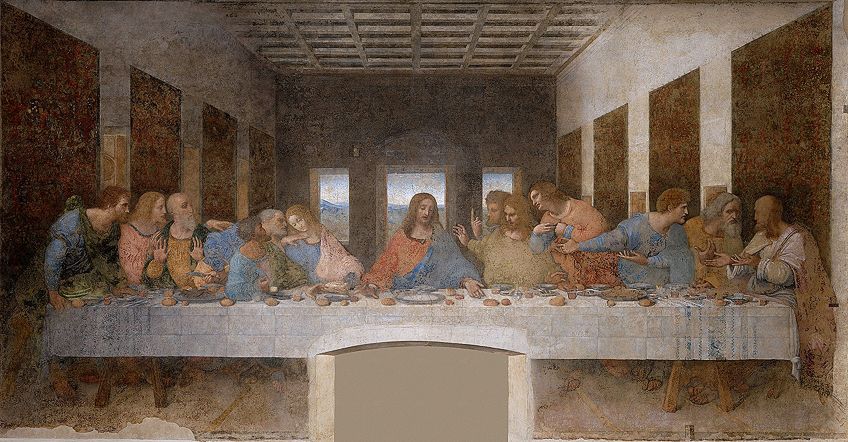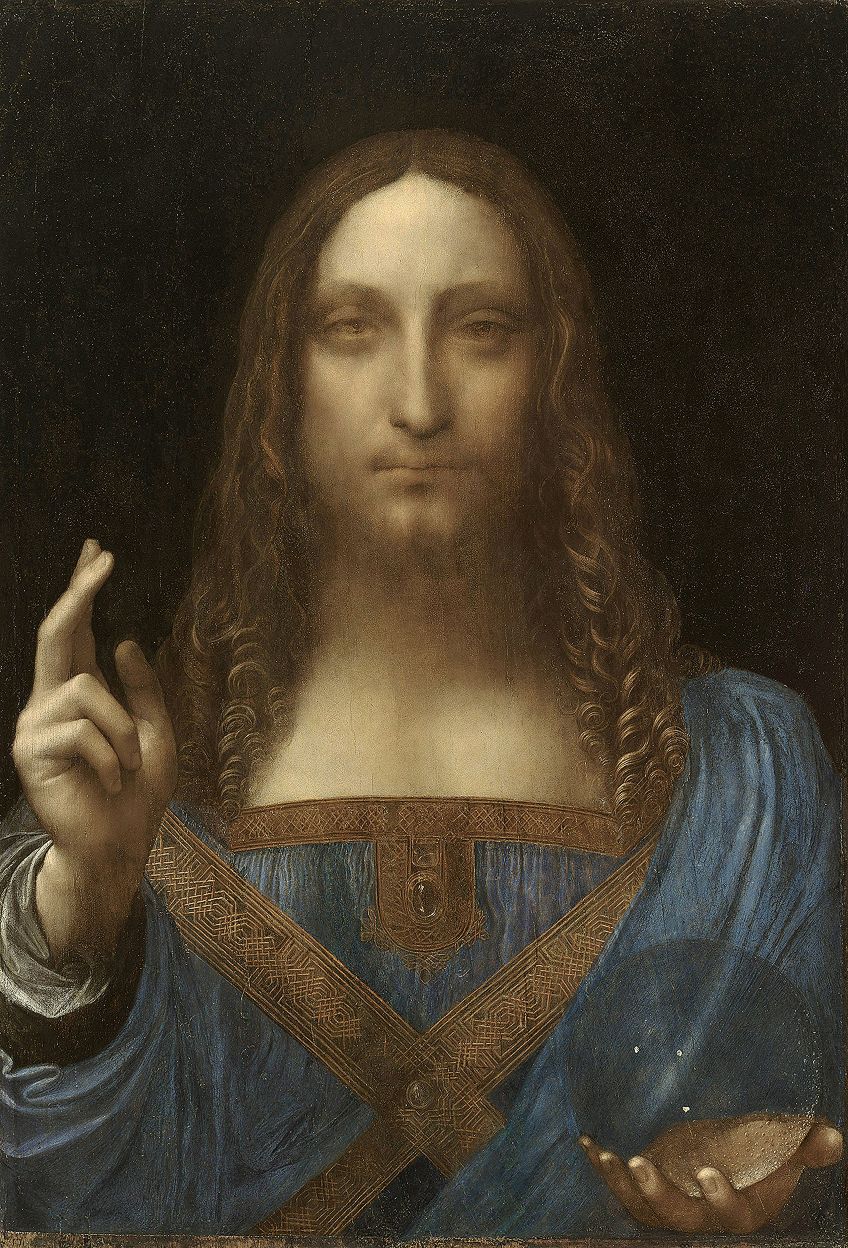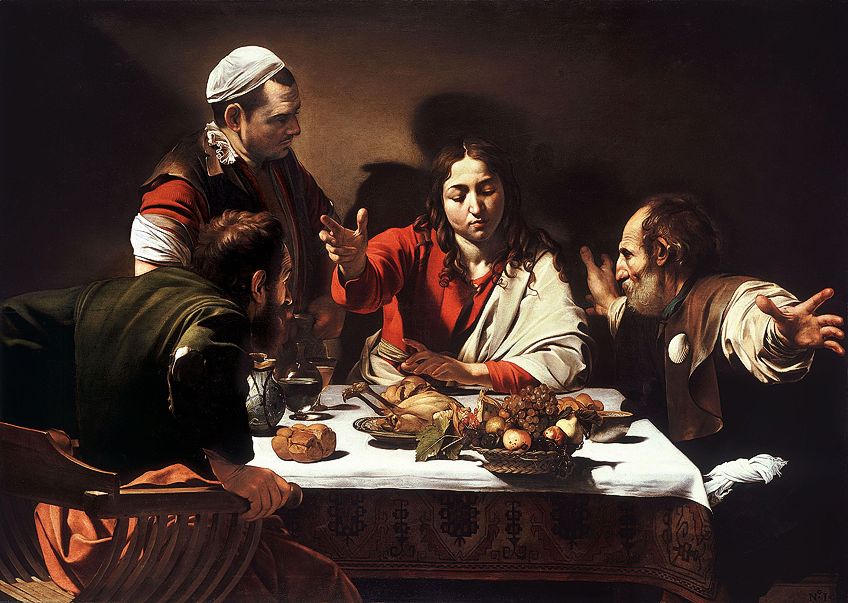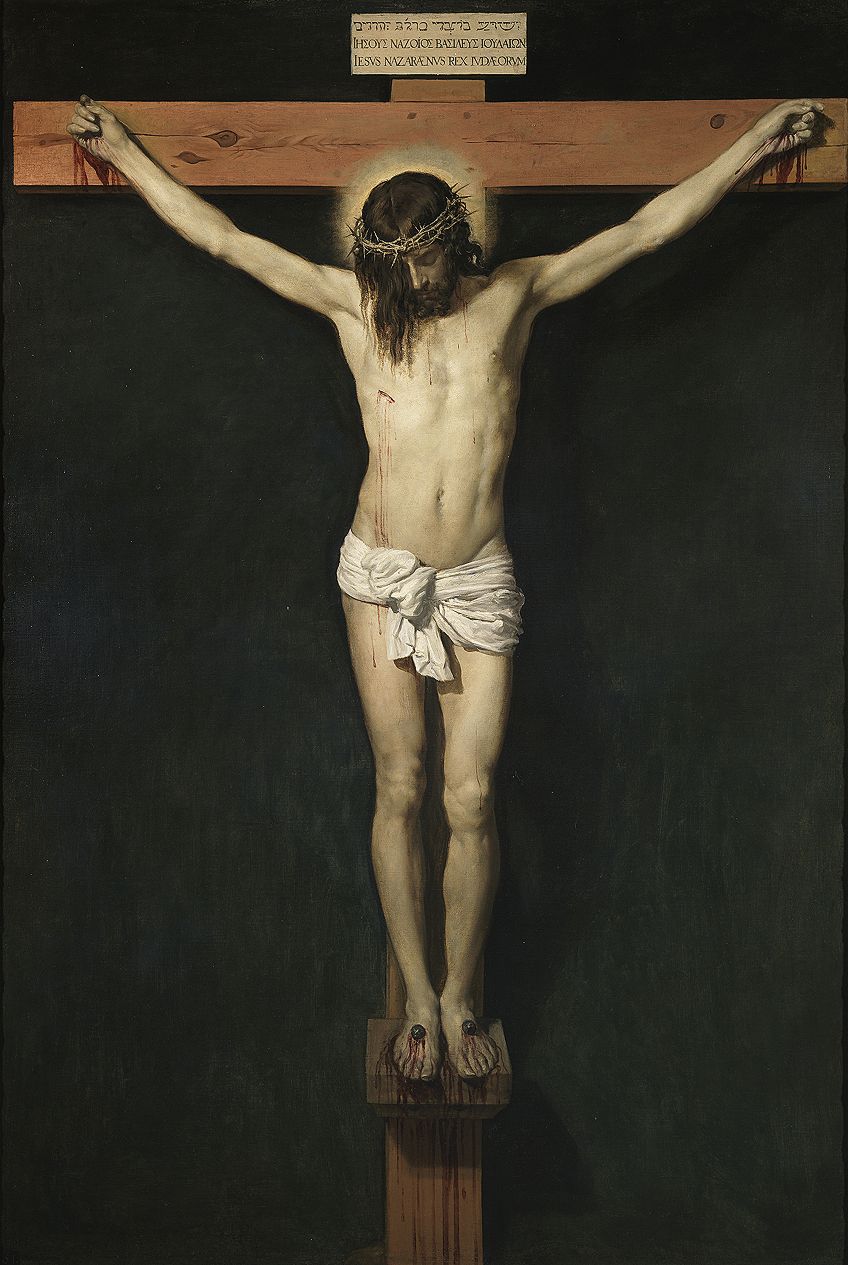What Is the Art Piece of Jesus Meal With the Other Men Called
Jesus must be one of the most iconic people in history. Thousands of Jesus paintings and Jesus drawings take been created through the ages, yet no 1 knows what he actually looks like. Fine art of Jesus Christ has been made past apprentice artists likewise as the masters, leaving behind many Jesus on the cantankerous paintings and other images of the divine existence.
Table of Contents
- 1 Jesus and Fine art
- 2 Famous Paintings of Jesus
- 2.i The Last Supper (1498) by Leonardo da Vinci
- 2.2 Salvator Mundi (1519) by Leonardo da Vinci
- ii.3 The Transfiguration (1520) by Raphael
- 2.4 The Terminal Judgment (1541) by Michelangelo
- 2.5 Christ Conveying the Cross (1580) by El Greco
- 2.6 Supper at Emmaus (1601) by Caravaggio
- 2.7 Christ Crucified (1632) past Diego Velazquez
- 2.8 The Yellowish Christ (1889) by Paul Gauguin
- 2.9 Crucifixion (1933) by Francis Bacon
- 2.10 Christ of Saint John on the Cross (1951) by Salvador Dali
- 3 Often Asked Questions
- iii.1 Why Was Jesus Depicted as a White European Human being?
- 3.ii Are Paintings of Jesus Expensive?
- 3.3 How Old Is the Oldest Painting Of Jesus?
Jesus and Art
The oldest painting of Jesus that we know about was painted around 235 Advertizement and was discovered in Syrian arab republic. It portrays Christ as a homo in his youth, without any facial hair, and he is depicted in a manner that exudes dignity and potency. He has been portrayed with short pilus and dressed in a pallium and tunic – the attire of a well-bred philosopher from the Greco-Roman era. In later versions, he is portrayed equally slightly maturer and sporting a full beard.
 A mural painting from the crypt of Commodilla, this is one of the first disguised images of Christ. Earlier Christian art in Rome portrayed Jesus most often as the Skilful Shepherd, bearded as Orpheus, immature, beardless, and in a brusk tunic. During the quaternary century, Jesus was beginning to be depicted as a man of identifiably Jewish appearance, with a full beard and long hair, a mode not usually worn by Romans. The symbols on either side are Alpha and Omega signifying "I am the beginning and the end;Public Domain, Link
A mural painting from the crypt of Commodilla, this is one of the first disguised images of Christ. Earlier Christian art in Rome portrayed Jesus most often as the Skilful Shepherd, bearded as Orpheus, immature, beardless, and in a brusk tunic. During the quaternary century, Jesus was beginning to be depicted as a man of identifiably Jewish appearance, with a full beard and long hair, a mode not usually worn by Romans. The symbols on either side are Alpha and Omega signifying "I am the beginning and the end;Public Domain, Link
Jesus was born in the center-eastern region of Galilee and therefore would most probable have had darker skin, curly pilus, and dark-brown eyes. Still, he is often portrayed as a European man with blue eyes and light hair.
Due to American and European Christians using their spiritual beliefs equally an excuse to oppress people from other racial groups, information technology would non have served their crusade to portray him as a person of color.
The Nazis from Germany were also responsible for trying to portray Christ equally an Aryan, and not anything like his true Jewish looks. In 1940, an image of Christ painted by Warner Sallman also became extremely pop and was reprinted on many products and objects, farther solidifying this incorrect image of a man from that region and fourth dimension.
Famous Paintings of Jesus
Despite at that place being no certain clues as to what the real image of Jesus might have looked similar, many painters have managed to capture his essence. Whether it is a portrait of Jesus, or i of the many Jesus on cross paintings, the context of the scene likewise as his divine expression, have managed to convey a sense of who the painting is meant to represent.
Today we will take a await at the most famous paintings of Jesus throughout history.
The Terminal Supper (1498) by Leonardo da Vinci
| Medium | Fresco (Paint and Plaster) |
| Twelvemonth of Painting'south Cosmos | 1498 |
| Dimensions of Artwork | four.6 one thousand x viii.8 m |
| Location Currently Housed | Santa Maria delle Grazie |
The Last Supper was painted in the 1490s equally role of a contract for Ludovico Sforza, Duke of Milan, to restore the church and its structures. On the mural, Jesus tells his followers at the Last Supper that he would exist betrayed past i of the people present. The original has been generally damaged by environmental causes, despite several attempts at repair over the years.
Equally early as the early 1500s, the artwork had already begun to flake and deteriorate, reaching the bespeak where it hardly resembled its previous splendor later on but fifty years. Early repair efforts just made things worse.
 The Concluding Supper (1495-1498) by Leonardo da Vinci;Leonardo da Vinci, Public domain, via Wikimedia Commons
The Concluding Supper (1495-1498) by Leonardo da Vinci;Leonardo da Vinci, Public domain, via Wikimedia Commons
Allied bombings during World War II created astringent vibrations that rocked the construction and severely damaged it. Much of the original paint had already been removed past the time the 19-year restoration project got underway in 1980. When a door was built in 1652 as role of repairs, a section of the painting on the bottom left, including Jesus's feet, was damaged. Scholars think that each fellow member of the group was modeled afterward a existent person.
Leonardo da Vinci intended Judas to take the traits of a contemptuous and hardened criminal. It's idea that he went through the Milan prisons looking for a suitable model for Judas.
Salvator Mundi (1519) by Leonardo da Vinci
| Medium | Oil on Walnut Panel |
| Twelvemonth of Painting's Creation | 1519 |
| Dimensions of Artwork | 45 x 65 cm |
| Location Currently Housed | Private Collection |
A multi-talented prodigy, Leonardo Da Vinci was an Italian painter who became famous for his innovations, inventions, and art. The bulk of his renown was earned every bit a painter during the side by side 4 centuries and he is still considered every bit one of the finest artists in Western fine art history today. Male monarch Charles I of England was the outset person to acquire this moving-picture show co-ordinate to records. The Duke of Buckingham'due south son sold it at sale in 1763, and Sir Francis Cook, an English art dealer, bought information technology in 1900.
 Salvator Mundi (c. 1500) past Leonardo da Vinci;Leonardo da Vinci, Public domain, via Wikimedia Commons
Salvator Mundi (c. 1500) past Leonardo da Vinci;Leonardo da Vinci, Public domain, via Wikimedia Commons
Sir Francis Cook'due south family unit later sold it for £45 at another sale. For many years, it was considered to exist a copy of a lost da Vinci painting by some other artist, simply later it was cleaned in 2006, numerous methods indicative of the chief'due south piece of work were evident and it was reattributed to him. In spite of its notoriety as the world's most plush artwork, many art historians nevertheless disagree whether it was painted by Leonardo da Vinci.
Christ is depicted every bit the globe's savior. It portrays him dressed in Renaissance garb, raising one mitt in benediction while belongings a crystal brawl in his other.
The Transfiguration (1520) by Raphael
| Medium | Oil on Canvas |
| Twelvemonth of Painting'south Creation | 1520 |
| Dimensions of Artwork | 410 10 279 cm |
| Location Currently Housed | Pinacoteca Vaticana, Vatican City |
In that location is footling incertitude that Raphael'south The Transfiguration is one of his finest works, every bit well as his last. It was deputed by Cardinal Giulio de Medici of the banking family of the aforementioned name. Originally intended for the Narbonne Cathedral in France, where it would have served as the middle entablature, it now resides in the Vatican's Pinacoteca Vaticana. Later Raphael's death, the painting wasn't sent to French republic. Instead of hanging on the cathedral's altarpiece, it was given to the Blessed Amadeo Church in 1523.
During Napoleon'due south 1797 campaign in Italy, information technology was taken by the soldiers from France and then exhibited in the Louvre Museum.
 The Transfiguration (1516-1520) by Raphael;Raphael, Public domain, via Wikimedia Commons
The Transfiguration (1516-1520) by Raphael;Raphael, Public domain, via Wikimedia Commons
This artwork can be observed every bit portraying two images that oppose each other at the base level. On the one side, you take Christ with his ability to redeem, the upper section of the composition is symbolic of the pure and symmetrical elements of the universe. On the lower department, the painting portrays Man and all of his shortcomings, represented by the scenes of chaos and gloom. This would exist the final work he would ever create and connected to piece of work on until the last days of his life.
After the stunning art of Jesus Christ was cleaned in the mid-1970s, it was revealed that he had done most of the work himself, with but a few of the beings in the bottom one-half being completed past his assistant painters.
The Final Judgment (1541) by Michelangelo
| Medium | Fresco (Paint and Plaster) |
| Year of Painting's Creation | 1541 |
| Dimensions of Artwork | fourteen k ten 12 1000 |
| Location Currently Housed | Sistine Chapel |
This massive masterpiece was created by Michelangelo and it takes up the complete wall of the Chapel'due south altar. Due to the number of people that he included in the composition, besides equally the sheer size and impracticalities, it took him effectually four years to finish the mammoth task. He began his work on the fresco about a quarter of a century after the chapel was beginning constructed, and when the piece was complete, he was already 67 years onetime.
Although the entirety of the men in the painting was portrayed every bit being naked, they were afterwards covered with draperies that were painted over the offending regions.
 The Last Judgement (1536-1541) by Michelangelo;Michelangelo, Public domain, via Wikimedia Commons
The Last Judgement (1536-1541) by Michelangelo;Michelangelo, Public domain, via Wikimedia Commons
Critics gave the piece a mixed reception, with some people criticizing the level of nudity and muscularity of the figures, while others heaped praise upon it. The fresco represents the day when Christ returns to earth to hand out Mankind'due south final judgment. Around 300 deceased beings tin be observed rising up towards the heavens, as Christ and his saints estimate the souls for worthiness. It was finished nether the reign of Pope Paul Iii, despite existence ordered to be painted past the previous Pope, Cloudless VII.
The conservative views of the later Pope would take been greatly influential in the decision to have the painting modified to exist more modest in its delineation of the human form.
Christ Carrying the Cantankerous (1580) past El Greco
| Medium | Oil on Canvass |
| Year of Painting'southward Creation | 1580 |
| Dimensions of Artwork | 105 cm x 79 cm |
| Location Currently Housed | Metropolitan Museum of Art, New York |
El Greco created many Jesus on the cross paintings throughout his illustrious career in Spain. This ane, even so, differs in the fact that there is no discernable context or groundwork, and the paradigm of Christ is the just one in the composition. Jesus is depicted carrying the full weight of the cross on the manner to his own crucifixion. It captures a moment of deep reflection as Christ intends to die to save humanity from its sins, the ultimate cocky-cede.
El Greco's paintings were genuinely unique since he blended the artistic elements of three separate eras and ideals of art.
 Christ Carrying the Cross (c. 1580) by El Greco;El Greco, CC0, via Wikimedia Commons
Christ Carrying the Cross (c. 1580) by El Greco;El Greco, CC0, via Wikimedia Commons
Overall, they absorbed a fresh spirit regarding the body's design. Greco'southward figures were frequently long, stretched shapes that were practically flowing in graphic symbol. His paintings were typically Romantic in nature and focused on how Human being suffered and loved through injure and contention. El Greco was also influenced by Renaissance techniques and ideals, specifically the notion that the platonic human form was a purified link to divinity. The majority of Greco'due south works depicted figures associated with this divine and iconoclastic state of existence.
El Greco's figures, on the other hand, were frequently distorted and elongated, in dissimilarity to the pure proportion and flawlessness of the Renaissance natural body shape.
Supper at Emmaus (1601) by Caravaggio
| Medium | Oil on Sheet |
| Year of Painting's Creation | 1601 |
| Dimensions of Artwork | 141 cm x 196 cm |
| Location Currently Housed | The National Gallery |
Caravaggio was an Italian painter whose works combined a precise study of the human condition, both emotional and physical, with lighting that was very dramatic. He is considered amidst the nigh important painters in Western art, and his paintings shaped the Baroque style of painting. Supper at Emmaus, i of Caravaggio's near renowned religious paintings, represents the moment when the risen Christ starting time showed himself to ii of his followers, about likely Cleopas and Luke, in the hamlet of Emmaus.
 Supper at Emmaus (1601) by Caravaggio; Caravaggio, Public domain, via Wikimedia Eatables
Supper at Emmaus (1601) by Caravaggio; Caravaggio, Public domain, via Wikimedia Eatables
In actuality, the Jesus painting portrays the exact moment the 2 apostles realize they are witnessing a supernatural event. Christ is seen beardless, and his billowing garments conceal any bear witness of the wounds he received through the Crucifixion. The groom, whose brow is sleek and his face is darkened, is standing there seemingly clueless about what's going on.
The moving-picture show is unique in that it features life-sized people against a black, empty backdrop. A still-life dinner is prepare up on the table. The food basket teeters precariously on the brink, but as the earth these disciples knew.
The unexalted nature is appropriate for this scenario since the human Jesus has rendered himself unrecognizable to his disciples and simultaneously affirms and transcends his humanity.
Christ Crucified (1632) by Diego Velazquez
| Medium | Oil on Sheet |
| Year of Painting'due south Creation | 1632 |
| Dimensions of Artwork | 249 cm ten 170 cm |
| Location Currently Housed | Museo del Prado, Madrid |
Espana'south Gilt Age artist and painter Diego Velazquez was active in the 17th century and ofttimes regarded as its almost important effigy. He is renowned for his portraits and served as King Philip IV's regal painter. This flick of Jesus on the cross, done by Velazquez in the heart of his career, shows him moments following his death. Apart from the cantankerous, the artwork is remarkable for its absenteeism of story elements.
A work of remarkable uniqueness and mastery in its combination of calm, grandeur, and majesty, this painting is regarded as a watershed moment in Velazquez's creative growth.
 Christ Crucified (c. 1632) by Diego Velázquez;Diego Velázquez, Public domain, via Wikimedia Commons
Christ Crucified (c. 1632) by Diego Velázquez;Diego Velázquez, Public domain, via Wikimedia Commons
It is the creative person's most famous religious moving-picture show and has influenced much poetry. The date of the artwork is unclear given the lack of documentation. Nonetheless, scholars think the painting was completed later on Velázquez's return from Italy, most likely between 1631 and 1632. The tranquil opinion of the trunk, the stylized visage, and the reclining head all reveal the influence of Classicist painting.
The influence of Caravaggism, on the other paw, can be observed in the intense chiaroscuro between the backdrop and the body, as well every bit the bright, artificial lighting in a higher place the cantankerous.
The Yellow Christ (1889) by Paul Gauguin
| Medium | Oil on Canvas |
| Year of Painting's Creation | 1889 |
| Dimensions of Artwork | 91 cm x 73 cm |
| Location Currently Housed | Albright-Knox Fine art Gallery |
Paul Gauguin was a French painter who was active largely throughout the nineteenth century and is today regarded as ane of the most prominent painters of the art style Post-Impressionism, which expanded Impressionism while rejecting its constraints. This painting, as with some other by Gauguin named The Green Christ, is considered one of the first and most essential pieces of Symbolism in fine art.
This painting depicts Christ's crucifixion in 19th-century northern France, while women gather in prayer.
 The Yellowish Christ (1889) by Paul Gauguin;Paul Gauguin, Public domain, via Wikimedia Commons
The Yellowish Christ (1889) by Paul Gauguin;Paul Gauguin, Public domain, via Wikimedia Commons
The composition is rich in symbolism, such as the person jogging in the groundwork, which represents the yearning of the 19th century for people to escape city life and return to a more "archaic" and basic fashion of life. Gauguin'south "synthetism" approach, as shown by the Yellow Christ, goes beyond symbolism. Brilliant colors and thick encircling outlines were used to make this, along with flat planes.
Crucifixion (1933) by Francis Bacon
| Medium | Oil on Canvas |
| Year of Painting's Creation | 1933 |
| Dimensions of Artwork | 62 cm x 48 cm |
| Location Currently Housed | Private Collection |
A far more contentious depiction of Jesus and the crucifixion, Francis Bacon painted this picture while he was only around 24 years of age. Bacon, one of the few contemporary painters on the list, spent a lot of time working on religious works. It was his first piece to garner widespread attention, and the gain from subsequent sales enabled him to beget his outset solo testify, which unfortunately received a poor review in the Times.
As a result, Bacon destroyed several of his previous paintings, including crucifixion pictures. He would after claim that the other crucifixion paintings were among the few that he regretted erasing.
Like many abstract paintings, this sort of work for the general public might be difficult to understand, merely it is only when viewed in the context of Bacon's previous work that its genius becomes apparent. An bathetic white human effigy with arms outstretched against a dark background is shown in this gloomy painting in black, white, and grayness tones. Lines signifying walls coming together a floor, likewise as the horizontal bar of the cantankerous, define space. Jesus on the crucifixion is represented every bit a stick effigy, with thin white arms looping around the cross, skinny legs, and the head, hands, and feet diminished to pale lumps.
Christ of Saint John on the Cross (1951) by Salvador Dali
| Medium | Oil on Canvas |
| Year of Painting's Creation | 1951 |
| Dimensions of Artwork | 205 cm x 116 cm |
| Location Currently Housed | Kelvingrove Fine art Gallery |
Surrealism'southward most important artist, Salvador Dali, is internationally recognized. The artwork is referred to as Christ of Saint John of the Cantankerous because of its design, which was influenced by a sketch by the 16th-century Spanish Franciscan John of the Cross. The artillery of Christ and the horizontal of the cross make a triangle, while Christ'south head forms a circumvolve in the composition. It is possible to interpret the triangle as a nod to the Holy Trinity, just the circumvolve may stand for unity, which means that everything is interconnected. Despite the fact that it depicts the crucifixion, the artwork is complimentary of nails and blood.
After a catholic dream in which he was concerned that depicting nails and blood would backbite from Christ'southward image, Dali decided to pigment this picture.
Scotland's favorite picture, Christ of Saint John of the Cross was selected in a 2006 survey. It'due south one of the virtually well-known pieces by a major contemporary artist, and it's often regarded every bit the best religious painting of the twentieth century. Dal had Hollywood stuntman Russell Saunders hung from an above scaffolding to discover how the body would look from the required perspective and to imagine the strength of gravity on the human body in order to construct the image of Christ. The body of h2o portrayed is the bay of Port Lligat, Dal'due south business firm at the time of the painting.
Today we accept learned nearly some of the most famous paintings of Jesus. The portrait of Jesus is an age-former prototype that has inverse over fourth dimension. Jesus art is as varied as there are styles of painting, with Jesus drawings plant in every movement and style. The art of Jesus Christ continues to inspire and fascinate religious people. From Jesus paintings that depict Christ amongst his disciples to Jesus on the cross paintings that depict him alone and dying, nosotros promise you take enjoyed our elevation list of famous paintings of Jesus.
Take a look at our Jesus art webstory here!
Frequently Asked Questions
Why Was Jesus Depicted as a White European Man?
Considering Jesus was born in Galilee, a location in the Middle Eastward, he most probable had a darker complexion, curly hair, and brown eyes. Yet, he is frequently shown every bit a white male with blonde hair and blue eyes. Because Christians in the United States and Europe use their religious behavior as a justification for oppressing people of colour, portraying him every bit a blackness human would take fit their purposes. It was the High german Nazis that portrayed Christ every bit an Aryan and not at all like his genuine Jewish appearance. Another iconic image of Christ, painted by Warner Sallman in 1940, was replicated on a variety of items and objects, further reinforcing the erroneous perception of a human from that identify and menses.
Are Paintings of Jesus Expensive?
The nigh expensive painting ever sold was a portrait of Jesus painted by Leonardo da Vinci. The painting is called Salvator Mundi and sold for $475 one thousand thousand.
How Old Is the Oldest Painting Of Jesus?
The oldest painting of Jesus around was painted in 235 Advert. It was discovered in Syria and portrays Christ as a young beardless homo.
corbinhaversidne39.blogspot.com
Source: https://artincontext.org/famous-paintings-of-jesus/
0 Response to "What Is the Art Piece of Jesus Meal With the Other Men Called"
Postar um comentário